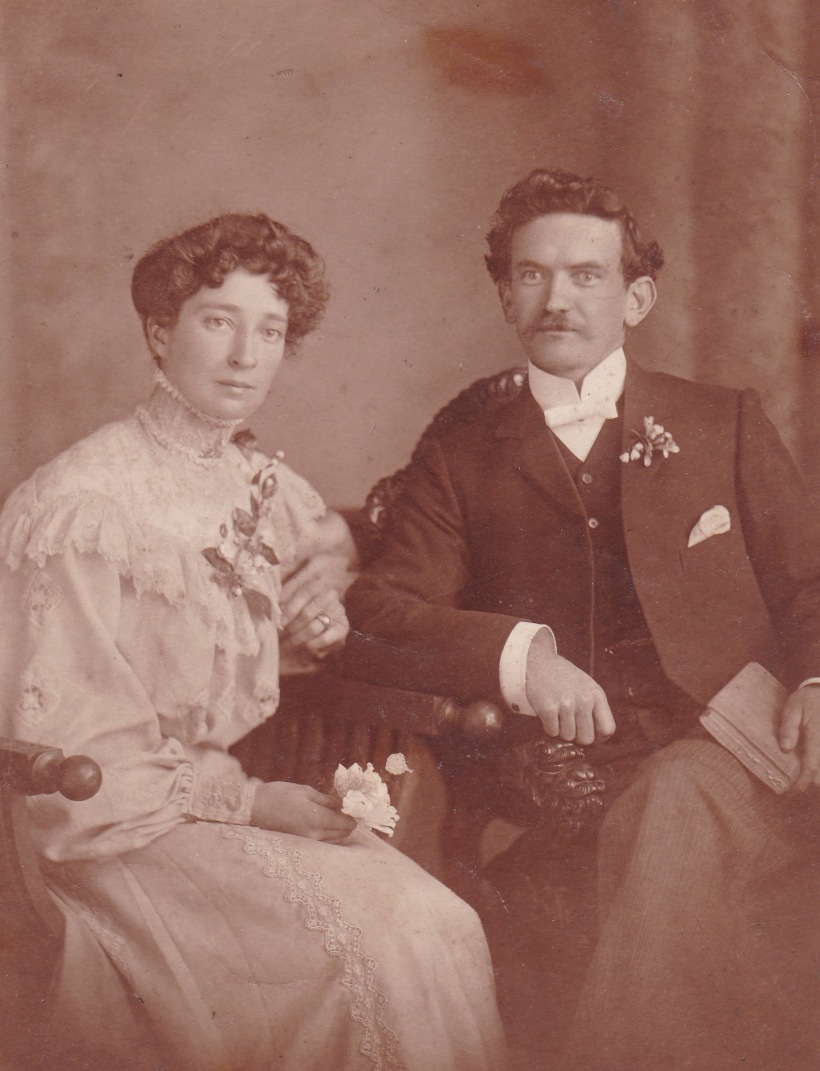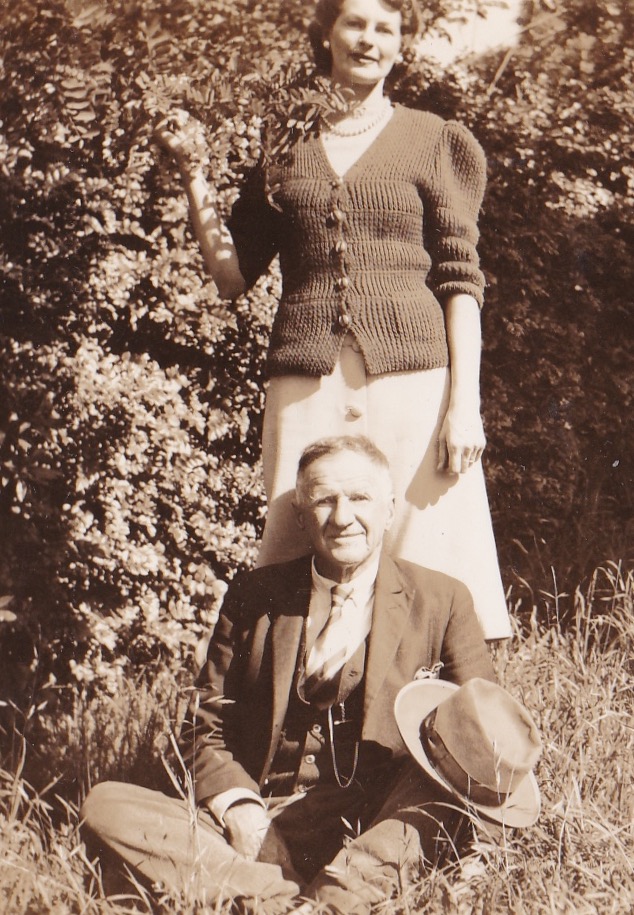Boonal (pronounced B’nall as in shawl), Bogan Gate, Boggabilla, Berrigagama, Bogan River, Barcoo, Boggabri, Budgery… These are names that swirled around my impressionable ears as the adults talked. Hundreds of unlabelled, sepia photographs of horses, cows, lambs, droughts, farmhouses, buggies and early model cars show tantalising hints of my paternal grandmother’s life as a widow.

When my grandfather, the stationmaster, died suddenly, my father was only six years old. Ella was 38 and had to make ends meet. Her photos published in the Grazier’s Review give a Rose Bay, Sydney, address but they indicate she had travelled widely to stations all over NSW and Queensland. She worked as housekeeper and station cook. Her published stories describe “The Station Woodhead” and “Drought in the Outback”. She called herself Ixia and Ilex in various publications and wrote rather strict, moralistic articles on modern trends as well as descriptions of life in the bush.
So what happened between 1913 (when John Henry Price died in Bogan Gate) and 1930 when she appears at Boonal working for Mr Munro? I recently found a document in the NSW Will Book 1800-1952. It seems that Ella and Linden moved to Marrickville, Sydney after the sudden death of her husband. She may have been staying with relatives as her mother-in-law lived there. It seems John Price didn’t make a will but she ended up with £504-4-6. I wonder did she put aside this money for Linden’s education and then answer an advertisement for a job as housekeeper and cook for Mr Munro? She may have worked for other people first but I am pretty sure when my father started Newington in 1918 she was in Mr Munro’s employ.

An article I found on the internet entitled THE MUNRO’S OF WEEBOLLABOLLA by Judy, Jac, Jen, Sandy, Treen and Kirst, descendants of the pastoral family, mention my grandmother’s employer Alfred Munro, once:
Alfred (the second son) received 3,865 acres of Boonal on which he lived, unmarried until he died in 1974 at 100 years of age.
This is incorrect because Alfred died in a Bundanoon Nursing Home at the age of 99. I know because I visited him every second Sunday with my mother. Also of interest in the article
Charles Alexander, a popular and capable man and the third of Alec’s sons, received 3,064 acres of Boonal. He established a Poll Shorthorn stud at Kondar, Goondiwindi with poll cows from the Goodar herd which he selected as part of his entitlement.
This might infer that Alfred was neither capable or popular. In spite of this (or maybe because) Alfred seems to have moved about a lot, managing various stations, with my grandmother in tow. Although she denied it, I wonder if he paid for my father to go to Newington? My father told me that a position was found for him as a trainee wool classer when he left school and Mr Munro offered to pay for him to attend university in Scotland. He turned down the university offer and left wool classing after deciding he wanted to be his own boss. When my father met my mother her life became inextricably linked to Alfred Munro as well.

In 2013 an article appeared which showed Boonal was still a station although somewhat changed from the ‘20s and ‘30s.
Fifth-generation farmer Sandy Munro is taking advantage of renewed corporate interest in large rural operations, putting his family’s $30 million-plus Boonal station in northern NSW up for sale. The 9800-hectare Boonal station is in the Moree-Goondiwindi district, one of the wealthiest agricultural regions in Australia.
In order to find where my grandmother Ella lived between 1913 and 1930 I traced Alfred Munro’s whereabouts. As a station manager his name appeared more often than my grandmother’s.
In 1913 he resided at Lignum Station, Yetman. In Wikipedia it states, “The thick rabbit and prickly-pear-ridden scrub of the Brigalow and Belah country was reclaimed from expiring leases in the 1920s and the back-breaking work of rendering it fit for agriculture did not bear fruit until the 1950s when wheat-growing became and remains a highly successful enterprise”.

It doesn’t sound like a desirable location at the time but Alfred was there in 1913-1914, back to Boonal in 1915 and then in Lignum from 1916 to 1920.

In her published photographs Ella shows scenes from Mulga Downs, Cunnamulla in South West Queensland, the property of Mr Paul Lamerand. In one of the pictures is the Christmas mail crossing the flooded Bogan. I think it is the same square boat where my father and his “little friend” are photographed on the Bogan River in June 1914.


Meanwhile I found my grandmother as a housekeeper in 1922 at Dirranbandi, which is in south west Queensland also. After searching through thousands of records this is where I am. I know Ella and Alfred went to Norfolk Island during World War 2 and have hundreds of photos to prove it, but that is another story.
I love the sepia tinted pics seen here. Your mother looks beautiful in the picture.
———-
Vinodini
http://ifsbutsandsetcs.com
LikeLiked by 1 person
Isn’t it great to find out where your ancestors came from and to see their photographs!! 🙂 A truly rural family there! It also seems to me that a lot of outback place names begin with B! 🙂
LikeLiked by 1 person
You are very lucky to have all this information. My family knows some but wish it was more. Sad I didn’t think to ask my great-grandmother or grandparents any questions about their lives while they were alive. Enjoyed your post.
Cheryl
Plucking Of My Heartstrings
LikeLiked by 1 person
I have found out a lot more by taking out a year’s subscription to Ancestry.com. There are still a lot of unanswered questions, however. Thanks for your comment.
LikeLiked by 1 person
She certainly got around, an interesting research trail for you. You have some great photos there, I’m just beginning to find some for my parent’s earlier years.
LikeLiked by 1 person
Being an only child of two only children I became the recipient of everything!!!
LikeLike
Linda, I really enjoyed reading this and my mind was darting left right and centre thinking about possible connections. My first ancestor to arrive in Australia arrived in 1818 and my husband goes back to 1808. Longed to find a first fleeter, but lucked out. I’ve come close to proving a connection with Henry Lawson’s mother Louisa, which I must keep looking into. However, perhaps the possibility is better than finding out it’s a no. I’ve also been exploring the family histories of the soldiers I’m researching, and that’s taken me to Newington a few times over. I love historic research and often have my nose buried in the old newspapers online while having no idea what’s happening in the present. That’s changed since the coronavirus upturned everything. We are currently history makers and records, which is interesting. I listened to a fascinating podcast today from a journalist with the Irish News and she cracked a story of conronavirus being fobbed off in the Netherlands in the early days. It was fascinating and I loved the accents and being in the thick of the news. Much better than listening to the news on TV.
Best wishes,
Rowena
LikeLiked by 1 person
Hello my name is Jane Munro and I would really like to get in contact with you. My number is 0427334620
LikeLike
Hi Jane, I tried to ring but went to message bank (which was full)😀I’ll try again tomorrow.
LikeLike